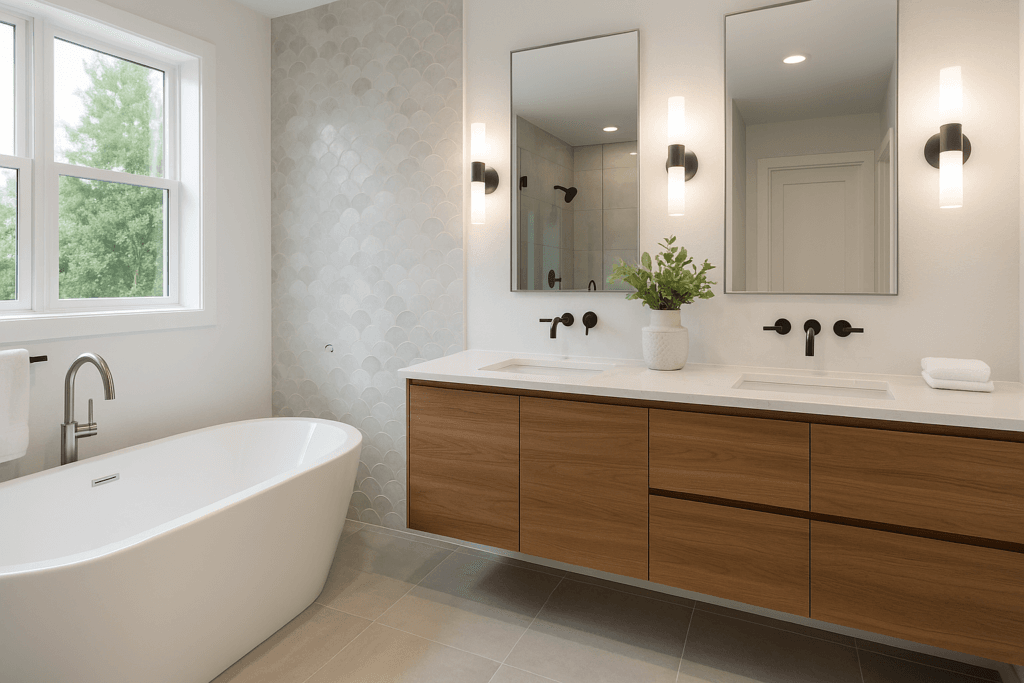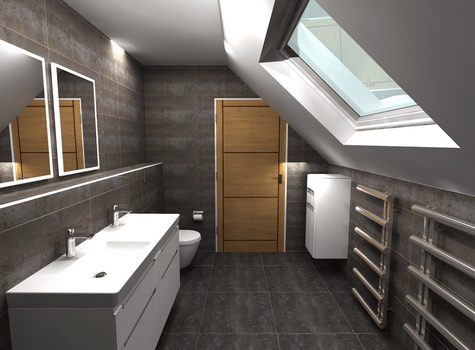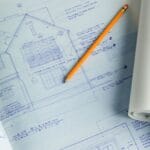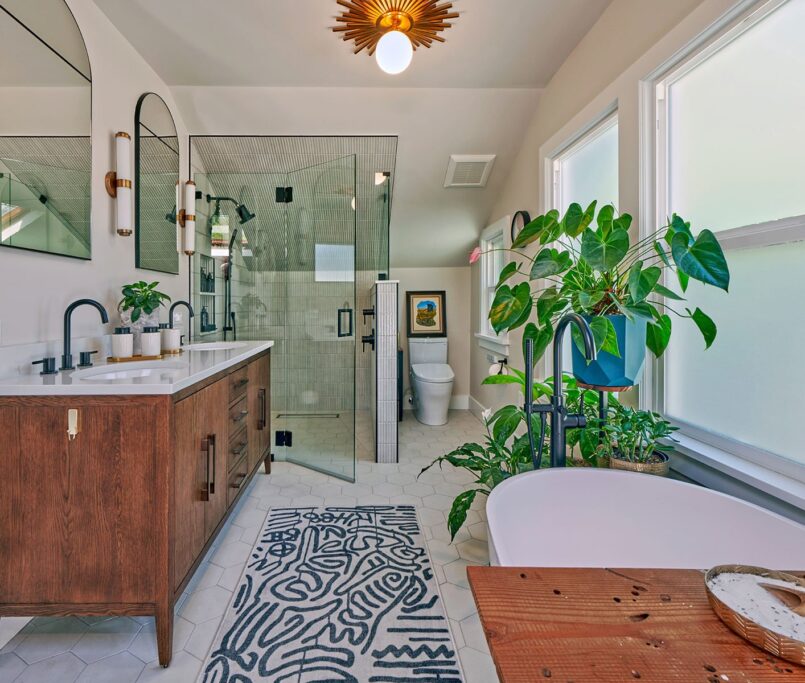Your Step-by-Step Roadmap to a Successful Bathroom Remodel in 2025
Bathroom remodeling continues to be one of the most popular and impactful home upgrades you can make. It’s a space you use every day for routines, relaxation, and everything in between. Whether your current bathroom is outdated, dysfunctional, or just doesn’t feel like it fits your lifestyle, a thoughtful remodel can completely change how you experience your home.
But great results don’t happen by accident. A successful remodel depends on good planning, smart budgeting, and working with the right professionals. In this comprehensive guide, we’ll walk through each part of the remodeling process so you can feel confident at every stage.
If you’ve already explored our deep dives into the average costs of a bathroom remodel, how to find a qualified contractor, or what’s trending in bathroom designs for 2025, this guide ties all those pieces together and gives you a full picture from idea to finished space.
Laying the Groundwork: What to Do Before You Start Tearing Things Out
The best bathroom remodels begin long before any tools come out. The first phase of your project should focus on clarity, knowing exactly what you want and why you want it.
Start by identifying the purpose behind your remodel. Are you renovating to increase resale value? Fixing functionality issues like poor lighting or lack of storage? Or are you simply ready for a space that feels more peaceful and modern? Your “why” will help you make better decisions throughout the project.
Next, take a close look at your current bathroom. What works? What doesn’t? Are there layout problems? Do you need more storage or a more efficient shower setup? Write down your must-haves and nice-to-haves. Having a checklist like this will keep you focused and help your contractor understand your priorities.
Think about your timeline, too. A standard bathroom renovation can take several weeks, and more extensive projects may stretch into two months or more. Be prepared for some disruption and make plans for how you’ll manage without the space during construction.
If you’re feeling overwhelmed with choices, start gathering visual inspiration. Save photos of layouts, finishes, lighting, and color palettes that resonate with you. These reference points will guide your design and help your contractor or designer bring your vision to life.
And of course, before you dive in too far, get familiar with your budget range. You’ll find more details in our full guide to bathroom remodeling budget planning, which helps break down everything from material pricing to labor costs.
Understanding the True Cost of a Bathroom Remodel
One of the first and most important questions every homeowner asks is: how much is this really going to cost? And the honest answer is it depends. A bathroom remodel can be modest or extravagant, depending on the size of the space, the complexity of the work, and the types of materials and fixtures you choose.
In 2025, a small bathroom with minor updates like new paint, lighting, and simple fixture swaps may come in under $10,000. On the other hand, a full-scale renovation involving plumbing changes, premium tile work, custom vanities, or high-tech features can easily exceed $30,000. Most mid-range remodels tend to fall somewhere between $15,000 and $25,000, offering a balance of quality upgrades without luxury pricing.
It’s also important to understand what goes into these numbers. Labor is often the biggest single expense, sometimes accounting for up to half the total cost. That includes plumbers, electricians, tile installers, and contractors coordinating the work. Material choices come next: vanities, countertops, flooring, lighting, and fixtures and these can vary widely in price depending on style, brand, and quality.
Then there are the surprise costs. Once demolition starts, it’s not uncommon to discover outdated plumbing, hidden mold, or subfloor damage. These problems aren’t always visible at first but must be addressed before the new work can continue. That’s why experienced remodelers always recommend setting aside at least 10 to 20 percent of your budget as a cushion for the unexpected.
To get a clear picture of how much each part of your remodel might cost, check out our full article on the cost breakdown of remodeling a bathroom. It outlines average prices for each component, from tile to tubs, and helps you build a realistic estimate for your space.
Permits, Approvals, and the Rules You Shouldn’t Ignore
Permits may not be the most exciting part of a bathroom remodel, but they’re absolutely essential when it comes to doing things the right way. If your renovation involves more than just cosmetic changes like moving plumbing, adding electrical outlets, or changing structural elements you’ll likely need one or more permits before work begins.
Each city or county has its own rules, but in general, a permit is required whenever the work affects the mechanical, plumbing, or electrical systems in your home. Swapping out a sink or toilet? Usually fine. Moving that same sink to a new wall? Now you’re in permit territory. The same goes for installing new lighting in a different location or building out a larger shower area that affects framing or waterproofing.
Working without proper approval can create major problems down the line. If an inspector finds unpermitted work, you may be required to tear it out or pay hefty fines. Worse, it could affect your home’s resale value or cause issues with homeowners insurance in the event of water damage or an electrical fire.
Getting a permit isn’t usually complicated, but it does take time. Most local building departments require you or your contractor to submit a set of plans and wait for official review. Once approved, inspections will be scheduled at different stages of the project often after plumbing and electrical rough-ins, and again at final completion.
If you’re hiring a contractor, make sure permit handling is included in their scope of work. A reliable pro will know exactly which permits are needed and how to get them quickly. If they try to avoid permits altogether, that’s a red flag worth paying attention to.
For a detailed explanation of what’s involved and how to stay compliant, visit our full guide to permit requirements for bathroom remodeling projects. It breaks down the common types of permits, expected timelines, and how inspections fit into the remodeling process.
How to Choose the Right Contractor for the Job
The person you hire to remodel your bathroom will have a direct impact on everything from the quality of the final result to how stressful or smooth the process feels. That’s why choosing the right contractor is one of the most important decisions you’ll make throughout your renovation.
Start by narrowing your search to professionals who specialize in bathroom renovations. This might seem obvious, but not every contractor has experience with the unique challenges bathrooms present such as moisture control, waterproofing, and plumbing coordination. Ask for referrals from people you trust, and always take time to read reviews and explore portfolios of previous work.
Once you have a shortlist, set up interviews. A good contractor will take time to understand your goals, answer questions clearly, and offer practical suggestions based on your space and budget. They should also be able to walk you through their process including how they schedule work, who will be on-site, and how they handle unexpected issues.
Transparency is key. Ask for a detailed, written estimate that breaks down labor, materials, timelines, and payment terms. Be cautious of vague quotes or unusually low bids. In remodeling, you often get what you pay for, and cutting corners upfront can lead to poor workmanship or costly rework down the road.
Licensing and insurance are non-negotiable. Make sure your contractor has the proper credentials for your area and carries general liability insurance and worker’s comp coverage. These protect you in case of accidents or damage during the project.
Also, don’t forget to ask about communication. Who will be your point of contact? How often will you receive updates? A remodel can be a multi-week process, and staying informed will help things move forward without surprises.
For a full checklist of interview questions, contract essentials, and red flags to avoid, check out our article on picking the best contractor for your bathroom remodel. It’s designed to help you hire with confidence and avoid common mistakes homeowners often make when selecting a pro.
What’s Hot Right Now: Top Bathroom Design Trends for 2025
Bathroom design in 2025 is all about creating a relaxing retreat within your own home. The latest styles merge wellness, minimalism, and sustainability into spaces that feel both rejuvenating and eco-conscious. You’ll notice a move away from stark white toward warmer, more grounded palettes like sage, charcoal, and earth tones, which support a calm and inviting atmosphere.
Textural materials are also gaining popularity. Homeowners are choosing matte or honed stone, ribbed glass, and fluted wood finishes for vanities and accent walls. The contrast between smooth tile and tactile elements brings depth and character without overwhelming the senses. Statement features like bold patterned tiles on shower walls or a backsplash behind a freestanding tub create visual interest that feels intentional rather than trendy.
Freestanding tubs and open-concept showers are still going strong, especially when paired with frameless glass enclosures and waterfall showerheads. These features deliver an upscale spa experience at home. Floating vanities continue to dominate, while smart integrationslike built-in flooring and mirror lightingadd subtle high-tech flair. If you’re curious to explore more cutting-edge ideas, check out our curated selection of 2025 bathroom design trends to inspire your remodel to see real examples in action.
Smart features are becoming nonnegotiable. Voice-activated lights, programmable thermostats for heated floors, sleek digital faucets, and anti-fog mirrors with touch controls aren’t just convenient they elevate the sense of luxury. As these products become more accessible, they’re becoming expected parts of a modern bathroom.
Sustainability also remains a center point. Many homeowners are opting for water-conserving fixtures like dual-flush toilets, efficient showerheads, and motion-activated faucets. The trend toward recycled or sustainably sourced materials continues, with an emphasis on long-lasting durability and clean manufacturing processes. Choosing these features now helps reduce environmental impact long after your remodel is done.
Incorporating these trends enables you to create a bathroom that not only looks good but also feels good each time you step in. Whether your style leans bold or understated, focusing on balance, texture, and eco-friendly elements helps your design stand the test of time.
Moisture Protection and Mold Prevention
Behind every long-lasting bathroom remodel is a solid moisture management plan. Because bathrooms are constantly exposed to steam, splashes, and condensation, they’re also highly vulnerable to hidden water damage and mold growth. Even the most beautiful remodel can fail prematurely if water isn’t properly controlled from the start.
To prevent issues before they begin, moisture defense must be built into every layer of your project. That starts behind the walls, where proper waterproofing is essential. Cement boards or waterproof membranes should be used behind shower tile instead of standard drywall, which can quickly degrade when wet. Seams, corners, and penetrations must be sealed carefully using water-resistant products like silicone caulk or specialized waterproof tape.
The materials you choose play a role as well. Opt for surfaces that can stand up to daily humidity, like porcelain tile, quartz counters, and sealed grout. Avoid using standard wood products or unsealed stone unless you’re prepared for constant maintenance. Floors, especially in wet zones like around the tub or toilet, should be slip-resistant and properly sealed at every edge.
Ventilation is your second line of defense. A high-quality exhaust fan, properly vented to the outside, is critical for moving moist air out of the room quickly. If your space tends to fog up even with a fan running, you may need a more powerful model or a version with a built-in humidity sensor that runs automatically when moisture levels spike.
After your remodel is complete, regular upkeep will help you maintain that fresh, damage-free look. Wipe down surfaces frequently, repair cracked grout or worn-out caulk as soon as you spot it, and monitor plumbing fixtures for slow leaks or signs of seepage.
For a full strategy on avoiding long-term moisture problems, don’t miss our expert guide on how to protect your bathroom from mold and hidden water damage. It includes proven materials, installation tips, and post-remodel care habits that will keep your new space safe and clean for years to come.

Creating a Bathroom Budget That Works for You
No matter how large or small your remodel is, the budget sets the tone for everything else. A well-planned financial approach helps you avoid unexpected surprises, prioritize smartly, and finish your project without unnecessary stress. And the good news is, creating a realistic budget doesn’t have to be complicated it just requires a little structure and forward thinking.
Start by defining your overall budget limit, but don’t stop there. Break that total down into categories: materials, labor, permits, design help, and an emergency fund for surprise costs. That last one is especially important. Even well-planned projects encounter curveballs, such as outdated plumbing, hidden leaks, or code-required upgrades. Most professionals recommend setting aside at least 10 to 20 percent of your total budget for those “just in case” moments.
Once you know your range, you can start balancing your wants and needs. If radiant heated floors are a must-have, you might opt for affordable ceramic tile instead of premium stone to offset the cost. If you love the look of a custom vanity but need to trim expenses, a high-end ready-made option may be a smart middle ground. Successful remodels often come down to trade-offs knowing where to splurge and where to save.
It’s also smart to get multiple quotes for labor and installation. Prices vary between contractors and can shift based on workload, availability, and the scope of your project. A clear breakdown of each quote helps you compare apples to apples and ensures you’re not caught off guard later. Contact us for your bathroom remodeling project




